Land Cruiser Prado GRJ150 TRJ150 TRJ155 KDJ150 TRJ155 LJ150 - СИСТЕМА ЗАПУСКА ДВИГАТЕЛЯ 5L-E
INSPECT STARTER ASSEMBLY
INSPECT MAGNET STARTER SWITCH ASSEMBLY
INSPECT BRUSH
INSPECT STARTER BRUSH HOLDER ASSEMBLY
INSPECT STARTER YOKE ASSEMBLY
INSPECT STARTER ARMATURE ASSEMBLY
INSPECT STARTER CLUTCH SUB-ASSEMBLY
СТАРТЕР - ПРОВЕРКА
| 1. INSPECT STARTER ASSEMBLY |
- ПРЕДОСТЕРЕЖЕНИЕ:
- As a large electric current passes through the cable during this inspection, a thick cable must be used. If not, the cable may became hot and cause injury.
- ПРИМЕЧАНИЕ:
- The following tests must each be performed within 3 to 5 seconds to prevent the coil from burning out.
Mount the starter in a vise between aluminum plates.
Perform a pull-in test.
Remove the nut, and then disconnect the lead wire from terminal C.

Connect the battery to the magnet starter switch as shown in the illustration. Check that the clutch pinion gear extends.
| *1 | Terminal C |
| *2 | Terminal 50 |
If the clutch pinion gear does not move, inspect the magnet starter switch assembly. If the magnet starter switch assembly is not as specified, replace it.
Perform a holding test.

Disconnect the negative (-) terminal lead from terminal C with the condition specified in the pull-in test above being maintained. Check that the pinion gear remains extended.
| *1 | Terminal C |
If the clutch pinion gear returns inward, inspect the magnet starter switch assembly. If the magnet starter switch assembly is not as specified, replace it.
Inspect the clutch pinion gear return.
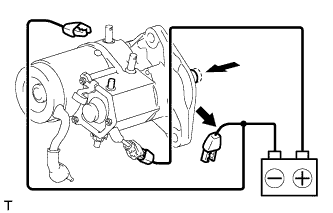
Disconnect the negative (-) terminal lead from the starter body. Check that the clutch pinion gear returns inward.
If the clutch pinion gear does not return inward, inspect the magnet starter switch assembly. If the magnet starter switch assembly is not as specified, replace it.
Perform an operation test without load.
Connect the field coil lead wire to terminal C.
- Момент затяжки:
- 5.9 N*m{ 60 kgf*cm, 52 in.*lbf}

Connect the battery and an ammeter to the starter as shown in the illustration.
| *1 | Terminal 30 |
| *2 | Terminal 50 |
Check that the starter rotates smoothly and steadily while the pinion gear is extended. Then measure the current.
- Specified current:
- 120 A or less at 11.5 V
If the result is not as specified, inspect the starter assembly.
- УКАЗАНИЕ:
- Inspect the starter brush holder assembly, starter yoke assembly and starter armature assembly. If there is a malfunction, replace the part and perform this test again.
| 2. INSPECT MAGNET STARTER SWITCH ASSEMBLY |
Inspect the pull-in coil.

Measure the resistance according to the value(s) in the table below.
- Standard Resistance:
Tester Connection Condition Specified Condition Terminal C - Terminal 50 Always Below 1 Ω
| *1 | Terminal C |
| *2 | Terminal 50 |
If the result is not as specified, replace the magnet starter switch assembly.
Inspect the holding coil.
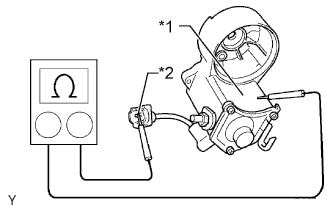
Measure the resistance according to the value(s) in the table below.
- Standard Resistance:
Tester Connection Condition Specified Condition Switch body - Terminal 50 Always Below 2 Ω
| *1 | Switch Body |
| *2 | Terminal 50 |
If the result is not as specified, replace the magnet starter switch assembly.
| 3. INSPECT BRUSH |

Using a vernier caliper, measure the brush length.
| *1 | Length |
| *a | Brush Holder Side |
| *b | Starter Yoke Side |
- Standard brush length:
- 16.5 mm (0.650 in.)
- Minimum brush length:
- 9.0 mm (0.354 in.)
| 4. INSPECT STARTER BRUSH HOLDER ASSEMBLY |

Measure the resistance according to the value(s) in the table below.
- Standard Resistance:
Tester Connection Condition Specified Condition Positive (+) brush holder - Negative (-) brush holder Always 10 kΩ or higher
Check the brush spring load.

Take a pull scale reading immediately after the brush spring separates from the brush.
- Standard spring load:
- 27 to 32 N (2.7 to 3.3 kgf, 6.0 to 7.3 lbf)
- Minimum spring load:
- 18 N (2 kgf, 4.0 lbf)
| *1 | Brush Spring |
| *2 | Brush |
If the spring load is less than the minimum, replace the brush holder assembly.
| 5. INSPECT STARTER YOKE ASSEMBLY |
Inspect for an open circuit.

Measure the resistance according to the value(s) in the table below.
- Standard Resistance:
Tester Connection Condition Specified Condition Lead wire - Brush Always Below 1 Ω
If the result is not as specified, replace the starter yoke assembly.
Inspect for a short circuit.
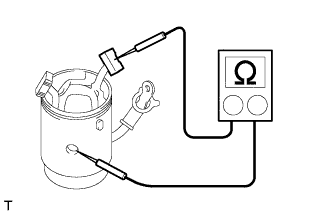
Measure the resistance according to the value(s) in the table below.
- Standard Resistance:
Tester Connection Condition Specified Condition Starter yoke body - Brush Always 10 kΩ or higher
If the result is not as specified, replace the starter yoke assembly.
| 6. INSPECT STARTER ARMATURE ASSEMBLY |
Check the commutator for dirt and/or burns on the surface.
If the surface is dirty or burnt, correct it with sandpaper (No. 400) or a lathe. Replace the armature if necessary.
Inspect the commutator for an open circuit.

Measure the resistance according to the value(s) in the table below.
- Standard Resistance:
Tester Connection Condition Specified Condition Segment - Segment Always Below 1 Ω
| *1 | Segment |
If the result is not as specified, replace the starter armature assembly.
Inspect the commutator for a short circuit.
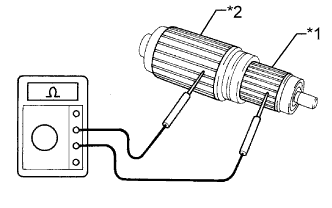
Measure the resistance according to the value(s) in the table below.
- Standard Resistance:
Tester Connection Condition Specified Condition Segment - Coil core Always 10 kΩ or higher
| *1 | Segment |
| *2 | Coil Core |
If the result is not as specified, replace the starter armature assembly.
Inspect the commutator circle runout.

Place the armature on V-blocks.
Using a dial indicator, measure the circle runout.
- Maximum circle runout:
- 0.05 mm (0.00197 in.)
If the runout is more than the maximum, correct it with sandpaper (No. 400) or replace the starter armature assembly.
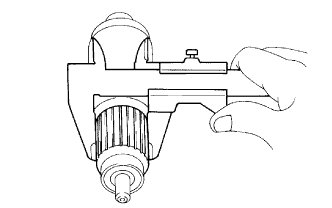
Using a vernier caliper, measure the commutator diameter.
- Standard diameter:
- 35.0 mm (1.38 in.)
- Minimum diameter:
- 34.0 mm (1.34 in.)
If the diameter is less than the minimum, replace the starter armature assembly.
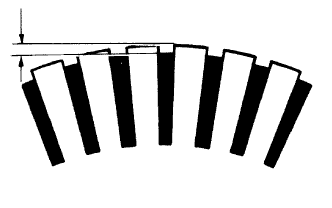
Measure the undercut depth of the commutator.
- Standard depth:
- 0.7 mm (0.0276 in.)
- Minimum depth:
- 0.2 mm (0.00787 in.)
If the undercut depth is less than the minimum, correct it with a hacksaw blade.
Inspect the bearings.
Check that the bearing rotates smoothly.
If the result is not as specified, replace the starter armature assembly.
| 7. INSPECT STARTER CLUTCH SUB-ASSEMBLY |
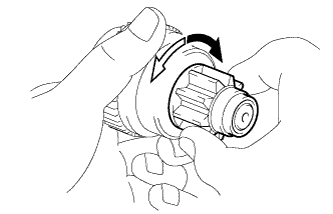
Rotate the pinion gear clockwise and check that it turns freely. Try to rotate the pinion gear counterclockwise and check that it locks.
 | Free |
 | Lock |
If the result is not as specified, replace the starter clutch sub-assembly.
Turn the pinion gear by hand while applying inward force and check the movement of the bearing.
If resistance is felt or the bearing sticks, replace the starter clutch sub-assembly.